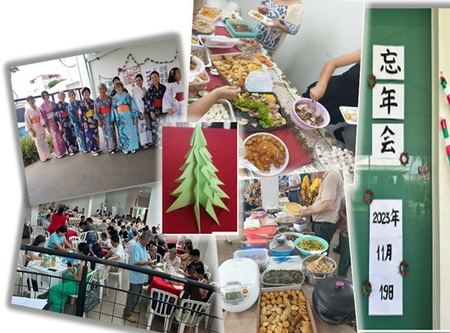You know the Oshōgatsu is coming when many people schedule the Bōnenkai, at least here in Brazil. The Bōnenkai is a meeting with other Nikkei in the mochiyori style, with each family bringing a plate of food to share. There are also volunteers who give musical presentations (karaoke) and other performances, bring gifts for bingos and play games, all with the aim of getting together and celebrating the end of the year and the arrival of the next.
In Brazil in general, the New Year is celebrated with people dressed in white clothes, symbolizing peace, eating a dish of lentils, placing 7 pomegranate seeds in their wallet wrapped in a banknote to attract abundance and fortune; there is also the custom of jumping 7 sea waves to attract good luck and ward off bad omens.
Before the New Year arrives, the first thing my Japanese-Brazilian family does for Oshōgatsu is clean the house and prepare a lot of gochisō, or Japanese feast. On January 1, we avoid sweeping the house and shopping. My father's idea is that the first day will determine the rest of the year. Therefore, if you spend money on the first day, it means you will spend a lot over the next 12 months. I personally don't believe in it, but these are traditions that have been passed down from generation to generation and it's better not to discuss it, because saving money is always good.
The presence of mochi spread throughout the house is also part of our Oshōgatsu to say thank you and wish good luck for the coming year. It is also our custom to eat ozōni soup, which is a very simple recipe that contains mochi and chives in a soy sauce broth with hondashi; and according to my parents, eating this dish brings prosperity for the New Year.
My mother also usually makes the recipe of oshiruko or zenzai in the Oshōgatsu, which consists of a sweet soup made with azuki beans, sugar and mochi and served hot. We generally don't make mochi; we prefer to order them since, in this period between Christmas and New Year’s, we are traveling with the family.
The last two weeks at the end of the year, between Christmas and New Year, is also a time when many companies go into recess. So Brazilians take that opportunity to get together with friends and family to go on vacation. People also go to church, as a large portion of Brazil's population are Christians who celebrate the birth of Jesus Christ during the Christmas season.
Another New Year custom is to give gifts or money in an envelope to friends and family. We write ‘thank you’ letters for the past year and set out your goals and desires for the next year. My father likes to watch the program Kōhaku Uta Gassen shown by the Japanese broadcaster NHK, which is a musical competition between two teams.
Fireworks are also present in the celebration of this festive period. I remember a funny uncle who lived in Curitiba who would always get together with the other neighbors for the New Year celebration. He would buy different types of rockets to set off on New Year's Eve. I was very scared, because it was something very improvised and amateur. Furthermore, the sound of the explosions was very noisy and strong, but they planned all year for this moment and at that time, the burning of pyrotechnic devices that produced booms was permitted.
The spectacle was very beautiful and it was very funny to see how excited those Brazilian and Japanese were with each other when they celebrate the arrival of the new year. Unfortunately, after a few New Year's Eves, the neighborhood made a petition and banned my uncle's traditional New Year's fireworks, because of the noise that bothered them; there was also an incident where a piece of firework fell on a neighbor’s house and almost started a fire.
In general, no matter the nationality, whether Japanese or Brazilian, everyone celebrates the New Year with loved ones together, surrounded by food, rituals and with hope for a better year. Oshōgatsu represents the beginning of a new cycle and the motivation for new opportunities.
Happy New Year!
© 2024 Meiry Mayumi Onohara







